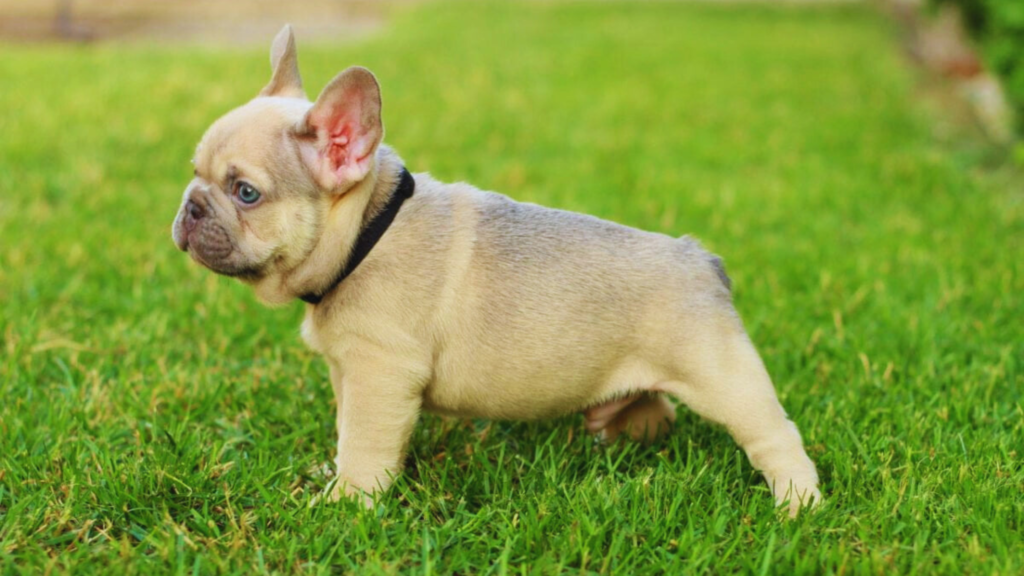Lilac Sable is a unique and rare color of French Bulldog. Lilac Sable has a coat color that is a diluted shade of chocolate brown, resulting in a pale, bluish-gray hue with just a touch of fawn or sable coloring. A recessive dilute gene induces this coloration to give the lilac color, while the presence of the sable gene leads to the coat being fawn or tan with black tips.
The French Bulldogs were produced as a smaller version of the English bulldogs by lace makers in England around 1800s. The dogs were imported to France by craftsmen and they were in demand among prostitutes known as “les belles de nuit” because of their small size and affable nature. In the late 1890s, French Bulldogs became fashionable, and consequently, The French Bulldog Club of America was established in 1898.
It is significant due to its scarcity and esthetic; Lilac Sable French Bulldogs are considered rare and often more expensive than other colors. However, it is important to focus on the dog’s health or behavior rather than coat color.
In summary, Lilac Sable French Bulldog is a unique and beautiful coloring variation for them which occurs rarely. It is not only rare but also distinct looking, hence making it one of the most craved companion dogs, however, its health status needs to be prioritized before its fur type. Thus, taking good care of it will make your Lilac Sable French Bulldog remain faithful and lovely forever.
Characteristics of Lilac Sable French Bulldogs
Physical appearance
- Coat Color and texture: The color of the coat of these Lilac Sable French Bulldogs is distinct, which is a light form of chocolate brown that gives it a paler bluish-Grey appearance with a hint of sable or fawn sort of color. The coat has hairs with darker tips than the base, creating a sable effect. The coat can have various shades, such as fawn or hints of red, giving it a distinctive and eye-catching appearance.
- Body structure and size: Lilac Sable French Bulldogs are typically compact and muscular dogs. They stand about 11 to 12 inches (27 to 30 cm) tall at the shoulder and weigh between 16 and 28 pounds (7 to 13 kg). These Frenchies have a small, powerful body with a deep chest, stout legs, and a short straight tail. Their distinct features include wrinkly punched-in face bat-like up-standing ears, and large expressive bug eyes.
Temperament
- Personality traits: Lilac Sable French Bulldogs are known for their sassy, dramatic, and confident personalities. They are brave protectors who make good watchdogs because they are loyal and vigilant by nature Despite having stubbornness as part of them they are intelligent and thus easily trained using positive reinforcement techniques like praise rewards treats etc. They are extremely sympathetic as well as attached to their owners, thriving on human companionship.
- Compatibility with families/ suitableness for families: Families that are ready for necessary training and socialization can find great companions in Lilac Sable French Bulldogs. These dogs love their owners dearly as they form strong bonds within their human families if not properly socialized they may be aggressive towards other dogs however generally get along well with other pets in the household due to their adaptability to small animals Harmonious interactions between cats dogs rabbits etc. is possible since these breeds read social cues.
Health Considerations
Common health issues in French Bulldogs
- Brachycephalic Obstructive Airway Syndrome (BOAS): French bulldogs have short skulls that make them have flat faces and hence experience difficulties in breathing due to this reason. This makes them prone to BOAS and other respiratory disorders such as problems of respiration.
- Heatstroke: For example, heatstroke occurs because French Bulldogs are more prone to it due to poor body temperature regulation, especially in this condition.
- Sensitive Skin: The skin folds and a genetic predisposition to skin problems found in French Bulldogs including Lilac Sable variations cause them to get skin infections and allergies.
- Ear Infections: Allergies and the shape of their narrow ear canals are what causes ear infections in French Bulldogs, including Lilac Sable variations.
Specific concerns for Lilac Sable variation
- Skin Sensitivity: The Lilac Sable French Bulldogs also may have issues with skin sensitivities specifically in their armpits, around their nose and mouth. They should be defended from harmful ultraviolet radiations and sunscreens are recommended on those in order to prevent skin illnesses.
- Eye Problems: Dogs with this coloration have more likelihood of suffering from different eye issues like ulcers on the cornea, cataracts, and “cherry eyes”. Therefore, it is important to have regular veterinary check-ups for the animal.
Tips for maintaining optimal health
- Consistent Grooming: Regular grooming should be done to prevent skin issues and maintain the health of a Lilac Sable French Bulldog’s fur.
- Health Watch: Continuous checkups are crucial for owners of Lilac Sable French Bulldogs to identify any form of respiratory distress, or skin infections among others before seeking immediate veterinary intervention.
- Proper Care: To maintain their overall wellbeing, you must feed your Lilac Sable French Bulldog with the right diet, ensure regular exercise, and take them to a vet in case of any issues.
Care and Maintenance of Lilac Sable French Bulldog
Grooming Requirements
A special care is required for a French Bulldog of the colour lilac sable, because of their unusual coat. Regular brushing helps prevent tangling and knotting in the longer hairs and therefore it should be done with a soft bristled brush or comb. They should be washed when necessary, using mild dog shampoo that matches the coat type, making sure that you rinse well in order not to irritate the skin. Furthermore, it is advisable to trim hair surrounding their face, paws and sanitary areas as this prevents matting thus promoting cleanliness. Folds around their mouth need regular cleaning as well as ears so that they can be free from infections in long-haired Frenchie.
Exercise Needs
French Bulldogs are notable for their low energy levels and ability to tire out easily, which is why they are prone to heat exhaustion. It is, therefore, significant that one avoids strenuous activities with them in hot weather, as well as create or ensure a cool indoor environment so that they don’t suffer from heat stroke. Limit walks and active play to cool periods and avoid engaging them in long periods of exercise. Using cooling dog bandanas can help keep them cool during hot months.
Nutritional Considerations
Lilac sable French Bulldogs, as an example, are gourmands and love their food. There is a need for balanced diet which can be done through proper feeding of these dogs. High-quality food that lacks allergens like chicken or grains can help to prevent skin irritations or other problems associated with foods.
Training and Socialization
Training a lilac sable French Bulldog requires patience and consistency. Starting training early, exposing them to various commands and rewarding their accomplishments, can help in their development into well-adjusted adult French Bulldogs. Frenchies can be stubborn and hard-headed, so firm and consistent training is crucial for their obedience and behavior. Establishing a housebreaking routine, rewarding good behavior, and supervising them at all times are key aspects of training and socialization for these dogs.
Breeding and Genetics
Understanding the genetics behind Lilac Sable coloring
The Lilac Sable color in French Bulldogs is because of the presence of multiple genes, including Agouti (A), Chocolate (B) and Dilute (D). The banding pattern on hair shaft is determined by Agouti gene while the chocolate gene changes intensity of black pigment into brown. The Dilute gene makes the color less intense leading to diluted shade.
Responsible breeding practices
To ensure the health and diversity of a breed, responsible breeding practices must involve the selection of appropriate breeders, genetic diversity conservation, and prevention of inbreeding. Breeders should also consider disease susceptibility and assurance that neither parent is affected by hereditary disorders or has poor disposition.
Potential breeding challenges and considerations
The potential breeding challenges/considerations for Lilac Sable French Bulldogs include rarity, which may necessitate deliberate choice of parents and a broader gene pool to ensure maintenance of genetic diversity. Furthermore, potential health concerns should be taken into account by the breeder, where both parents are required to have no genetic ailment and be of sound mind. Additionally, breeders should avoid exaggerated physical characteristics such as large skulls or narrow airways that can result in health problems.
Conclusion
Recap of Key Points
- The different colors of the French Bulldogs include Sable, which is challenging but not the rarest and Lilac, which is quite rare.
- Blue French Bulldogs are popular although with health risks associated with the dilute gene causing color dilution alopecia.
- There is no “best color” for a French Bulldog; personal preference and its health play a role in choosing a color.
- In comparison to other colorations tan French Bulldogs are less common, and their cost may differ depending on how rare their markings are.
- Selecting breeding pairs carefully, avoiding inbreeding, and taking genetic health issues into consideration are responsible breeding practices.
Appreciation for the Unique Qualities of Lilac Sable French Bulldogs
Lilac Sable French Bulldogs exhibit a unique and captivating coat color that sets them apart from other breeds of Frenchies. The complexity of their coloring, which blends lilac with sable shades, adds to the variety and attraction of the breed hence making them popular among enthusiasts. This distinct beauty reflects the rich genetic diversity within this breed and shows how responsible breeding can create art.
Encouragement for Responsible Ownership and Breeding Practices
It is significant for one to recognize and keep up Lilac Sable French Bulldogs’ special features through responsible ownership and breeding practices. The health, well-being and good behavior of a dog at home must be the priority for its owners. Breeders play a vital role in ensuring that the breed remains pure through observing ethical breeding standards, genetic testing and promoting well-being for all dogs. By being accountable owners, these loving companions can be assured of living long lives that will ensure their future is bright.

